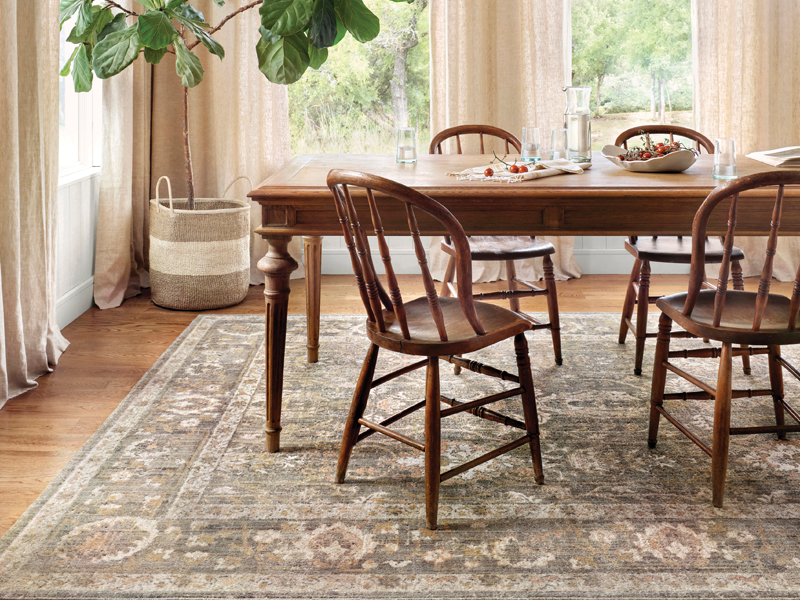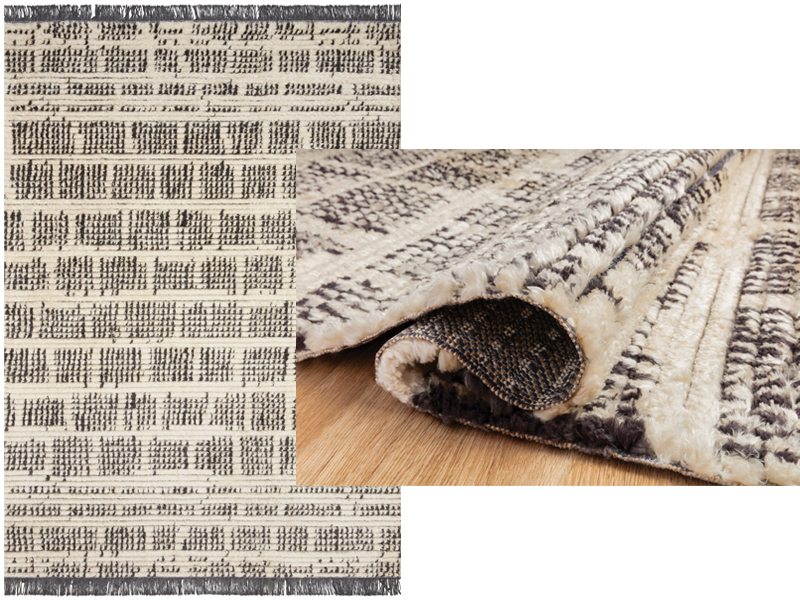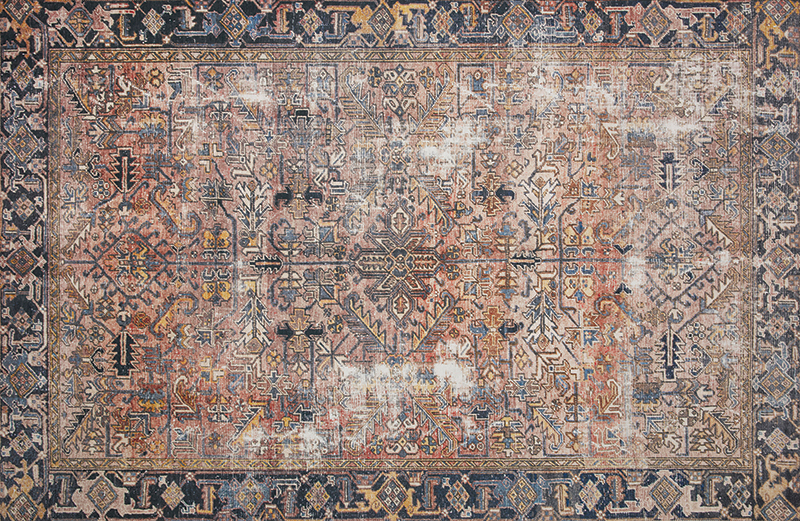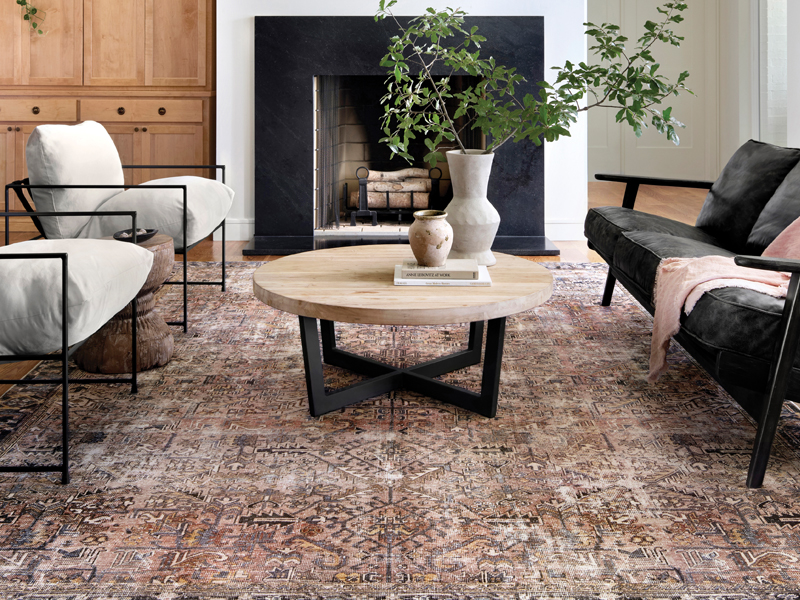Amidst unprecedented global change and disruption one firm caught the attention of RUG INSIDER Magazine due to its ability to seemingly have been prepared for the eventualities of 2020 and beyond.
The history of the trade of rugs and carpets is a long and storied affair. One steeped in both tradition as well as innovation. Be it design, materials, construction technique, manner of distribution, or the like, traders have embraced tradition—along with novelty, expedience, and the technology of the era—to advance the fortunes (and perhaps misfortunes) of the craft and trade.
It is at this uneasy yet lucrative intersection that the successful find the balance of past, present, and future, with the resulting mix perfectly in tune with the consumption habits of the era. Still, it all depends on an undeniable truth: service is meaningless without product that resonates with consumers, just as those same rugs and carpets aren’t sold without appropriate service. Loloi Rugs understand this well.
“Quality means doing it right when no one is looking,” said Austin Craley, Loloi’s Vice-president of Sales as I spoke to him about the success of the company. It is a statement that rings extraordinarily true for this writer. As someone who has at times fancied himself an expert on the rug trade, in recent years I have gravitated solely toward the ever more exclusive niche of handknotted, oft-ignoring more mass, or perhaps better said middle-market rugs and carpets. “A big portion of our sales come from furniture stores,” stated Craley. It is this distribution channel which in late 2020 piqued my attention.
“Understanding the problems and providing solutions is a core strength of Loloi, and it informs every aspect of their business.“
In addition to writing about rugs and carpets I work part-time for a local furniture store in the Canadian Maritimes; it not only affords me a consumer perspective, but also one of the store buyer. And frankly, it gets me out of my home office—which is is an always wise exercise for one’s mental health—but, I digress. The store’s product mix is decidedly modern and upmarket for the region. Yet, to be factually accurate, the customer base is not Alpha City wealthy. Nor is there a cultural affinity toward rugs other than perhaps locally made, hand-hooked or hand-braided mats. It is in this retail environment that I became familiar with the quality, service, and in-tune-with-the needs-and-wants-of-consumers approach of Loloi.

Showing rugs in room settings affords prospective customers inspiration as to how they might use the rugs in their own home. ROE-01 in Sage/Blush from the Chris Loves Julia X Loloi Rosemarie Collection draws inspiration from antique rug designs, mixed together with bold, unexpected color combinations. Power-loomed in Egypt of a polypropylene and polyester blend.
“It was a decision we made a few years ago,” said Craley of the firm’s decision to fully engage the Canadian market, “and, it was a bit of a chicken or an egg moment.” The firm was eager to expand into the generally underserved Canadian market. Yet, at only approximately 10% the size of the Unites States’ market, many of the same difficulties experienced by other cross-border rug traders continuously reared their ugly heads. Most notably: exchange rates, shipping costs, and duties and taxes. “We asked ourselves, ‘How can we earn that business?’” And thus, the firm established a Canadian distribution warehouse in Manitoba, concurrent with the introduction of a Canadian pricelist which quotes the to-the-door landed price of the rug in United States’ dollars. And while my inner Canadian asks, “Why not in Canadian dollars?” my practical self knows the international rug trade has long operated in USD and must allow for fluctuations in exchange.
For a furniture showroom not dissimilar to the aforementioned one in which I occasionally work, this offers service beyond that of veritably all United States’ based rug and carpets companies, including specifically those which I myself admire and purchase from. “How good can service actually be if it disregards the real-world concerns of consumers?” I ask rhetorically for the answer is clear. It’s not as good as Loloi’s. “For us, it [the Canadian dealer program] is an extension of our everyday policy,” explains Craley.

In addition to lifestyle or in situ photographs, Loloi Rugs Laos feature a variety of images to allow customers to get a better virtual feel for the rug as well as to gauge its construction. In the aerial image (above) one could on first glance assume ALI-02 CJ Cream/Charcoal from the Chris Loves Julia X Loloi Alice Collection to be Moroccan—as was the source inspiration— yet upon review of the detail (shown right) the power-loomed structure becomes readily apparent; at least to the experienced eye.
This policy of identifying needs and then catering to them dates back to the original vision of the firm when Amir Loloi founded it at a turning point in his own rug career. Now with son Cyrus Loloi also at the firm, Loloi Rugs continuously refines and occasionally redefines the answer to the question, “How do we earn that business?” To this commentator the recurrently correct answer is, as Craley stated, “We make it easy!”
This was already apparent to me from my own first-person interactions and dealings with the product and the firm’s Canadian distribution, but the brick and mortar trade is now just one of several elements in a hugely diversified distribution and marketing effort. “It used to be that all you needed was beautiful product,” Craley pointed out. “Now, however, we need this and we must make the customers’ job easier.”
While I’ll concede this sounds repetitive, for it is, I mention this again as it’s easy to fall into the trap of thinking one is making it easier, when in actuality the root “problem” itself is not even understood. Thusly, how can a solution which benefits consumers be successfully and beneficially implemented? Understanding the problems and providing solutions is a core strength of Loloi’s, and it informs every aspect of their business.
For example, several years ago Cyrus Loloi encouraged and spearheaded a very active social media campaign (@loloirugs). Realizing that younger audiences—read: millennials—consume information and shop differently than their older cohorts, and in part because the younger Loloi is a member of that generation, he pushed the company into “on target” social media designed to foster genuine brand awareness as a complement to traditional distribution channels.
While dealers and firm owner Amir Loloi were at first skeptical, after about two years the results convinced him of the merits of social media as well as the “necessary evil” of online shopping. All now made that much more apparent and relevant by the pandemic of 2020.
Speaking again from my own experience and from informal and anecdotal surveys of colleagues, it is safe to say 2020 has been a boon for sales of veritably any ware or luxury which makes the home enjoyable. Rugs certainly play a part, and for a firm like Loloi—which was already established in the so-called virtual world—the forethought has only aided in their virtual sales presentations this year.
Another example of Loloi Rugs’ identification and adaptation to perhaps unrealized market forces is a seemingly innocuous addition to their virtual presentations. While the de facto language of the United States is English, a sizeable portion of just over 13% speak Spanish. Loloi Rugs has seized on the opportunity to serve this demographic by offering its virtual presentations in the latter language as well.
As a resident of a fluently bi-lingual region (English and French) I cannot stress enough the comfort communicating in a customer’s preferred language offers to said customer. Nuance is conveyed, and a true sense of community and understanding are fostered. Assuming native speakers are employed, broader cultural standards—including those of design—are brought to bear in the sales process. Far from a faux assault on identity, it reminds we are all individual, especially when it comes to aesthetics and our appreciation thereof.
“Stocking rugs and moreover shipping them as quickly as possible is part and parcel to servicing this emerging demographic.“
Returning to 2020’s, and one presumes 2021’s continued frenzied focus on home, critical to capitalizing on this demand is the ability of a firm to deliver, on time, as fast as possible. “Younger cohorts of consumers have zero patience,” said Craley. As much as someone in my generation may bemoan such impatience, it is simply a natural consequence of the consumer-driven world my generation, and the one before before mine created for these younger, savvy consumers. If one wants to cater to their needs, one has to, wait for it, (again) make it easy. Stocking rugs and moreover shipping them as quickly as possible is part and parcel to servicing this emerging demographic. “Same-day shipping is our goal. We’re not there 100% of the time yet, but we’re close,” assures Craley.

JUL-02 CJ Terracotta / Multi from the Chris Loves Julia X Loloi Jules Collection represents the leading edge of decorative rugs, or should we say floorcoverings? Power-loomed in China of 100% polyester pile, the design is printed upon the surface thus mimicking the distressed vintage look of a worn hand-knotted carpet.
A third of but many examples of Loloi Rugs’ focus on identifying key areas of the market and then catering to them is the firm’s brilliantly executed licensed rug collections, including the newly-launched Chris Loves Julia X Loloi Collection featured herein as well as on the cover of this issue. In short, Loloi Rugs enjoys working with brands and personalities which offer more than just a name on a label. It’s about a synergistic relationship in which two brands combine expertise and perspective to create fresh rugs and carpets perfectly in tune with the time. For a pandemic era focused strongly on the home, the words of Chris & Julia (@chrislovesjulia) are appropriately succinct: “Thanks for following along as we uncover our home's potential. We hope you feel welcome and maybe find inspiration, because we should all love where we live.”
Hear them, hear them.
In examining the success of Loloi Rugs it would be easy for someone like myself—an at-times self-described “rug snob”—to dismiss the firm and its assortment of rugs. At the same time, I cannot forego the sentiment expressed earlier this year by Gaurav Sharma of Obeetee—and likewise reiterated elsewhere in this issue of Rug Insider Magazine—when he asked, “What will future floorcoverings look like?” If the past intersections of tradition and history and the needs and wants of the present are any indicator, it is worth broadening our perspectives, dismissing our prejudices, and searching for opportunities to be found within. It’s certainly working for Loloi Rugs.
loloirugs.com
Images courtesy of Loloi
